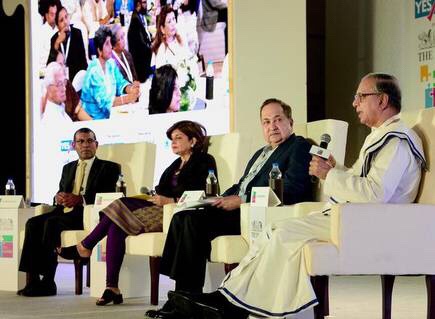The flight and fight of political exiles

Three South Asian leaders unpack their experience of living in distant lands with the constant urge to return
The difference between migrants and exiles is that exiles don’t unpack their bags, said Mohamed Nasheed, the former President of the Maldives, who has been living in exile since 2016. “And I don’t want to unpack my bag. I want to return back.”
In the opening panel discussion on “Exile: the challenges of leading from afar” at The Huddle, Mr. Nasheed, Farahnaz Ispahani, a Pakistani politician and human rights activist now living in Washington, DC, and S.C. Chandrahasan, a Sri Lankan human rights activist who worked with refugees who streamed into India since the anti-Tamil violence of 1983, shared their individual stories of flight and the hopes and interventions that keep a leader in exile going.
The exile’s condition is unique. Introducing the subject, the moderator, N. Ram, Chairman of The Hindu Group, noted that a migrant left for a better life, a refugee for safety, and an exile in order to return some day.
In a sense, the possibility of return for the leader of conscience in exile was associated with the cause of his or her disruptive flight being addressed, of the homeland being a better, kinder place.
Indian intervention
For Mr. Nasheed, it’s the eventual triumph of democracy — and with the political crisis deepening in the Maldives, he made a strong pitch for greater Indian intervention.
For Ms. Ispahani, a former MP in Pakistan and author recently of Purifying the Land of the Pure: A History of Pakistan’s Religious Minorities, it’s the safety and enfranchisement of the country’s minorities. This is her second spell in exile, the first being during the regime of Pervez Musharraf, and this time she said, “There will perhaps be no going back.” There has been a “soft coup” in Pakistan, she said, arguing that Nawaz Sharif’s removal as Prime Minister, upon disqualification by the Supreme Court, was “unconstitutional”.
But the call to action remains as valid, she said, of “keeping people’s dreams alive for a better day”. She works with activists and exile-seekers back home: “We are people they turn to when they need visas.”
For Mr. Chandrahasan, who returned to his Colombo home in 2011 after a 27-year exile, that return coincided with the ongoing rehabilitation, post-2010, of refugees and political reconciliation. His time away, in effect, was spent with those hunted out of their homes in Sri Lanka, to work for their care and to insulate them from extremist elements while they were in India.
An exiled leader, however, cannot be insulated from her people back home. If today there is WhatsApp and social media to keep communication going, said Ms. Ispahani, Ayatollah Khomeini used smuggled letters to reach his supporters in Iran, and Benazir Bhutto used her BlackBerry to keep in touch with leaders and workers of her Pakistan People’s Party.
Yet, conceded Mr. Chandrahasan, there is no denying the toll it takes on the exiled leader’s family. That is a “bigger challenge than anything”, added Mr. Nasheed. But he noted: “You get your strength by what’s happening at home … and wishful thinking.” He said he must fight today so that in the future his daughters could not be tortured as he was. Or as Ms. Ispahani pointed out, in exile you must keep alive ideas that are repressed back home.
Link to original post published by The Hindu – http://www.thehindu.com/news/national/the-flight-and-fight-of-political-exiles/article22786114.ece